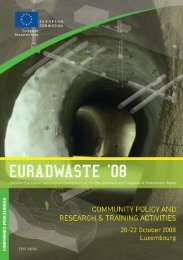EU industrial structure - EU Bookshop - Europa
EU industrial structure - EU Bookshop - Europa
EU industrial structure - EU Bookshop - Europa
Create successful ePaper yourself
Turn your PDF publications into a flip-book with our unique Google optimized e-Paper software.
<strong>EU</strong> <strong>industrial</strong> <strong>structure</strong> 2011 — Trends and Performance<br />
TAbLE IV.15: Indicators of RCA for intermediate goods according to technological intensity in 2009<br />
Exports imports<br />
low medium medium high low medium medium high<br />
tech low tech high tech tech tech low tech high tech tech<br />
Brazil 2.4 0.9 0.7 0.4 0.5 0.9 1.5 1.0<br />
china 1.5 0.7 0.7 1.6 0.5 0.8 1.2 1.4<br />
Eu‑27 0.9 0.9 1.2 1.0 1.2 1.0 0.8 1.1<br />
india 1.1 1.8 0.5 0.3 0.6 1.4 1.0 0.8<br />
Japan 0.2 0.9 1.7 1.0 1.6 0.8 0.8 1.0<br />
russia 0.2 2.6 0.2 0.0 1.6 0.7 1.2 0.8<br />
usa 0.7 1.0 1.3 0.9 1.0 0.9 1.0 1.2<br />
Source: own calculations using COMTRADE data.<br />
Even though the results in the table above are based on less<br />
aggregated data than in table IV.14, these aggregates also<br />
mask industry differences. There are differences even within<br />
industries, as different firms produce different varieties of<br />
goods. These varieties may not be substitutes if they differ<br />
in terms of quality: one way to analyse this is by looking<br />
at unit values. Unit values, trade values divided by trade<br />
volumes, are often used as indicators of price and qualities<br />
of different goods. The rationale is that countries exporting<br />
at higher unit values offer higher quality products. Unit<br />
values should, however, be used with caution. Unit values<br />
are imprecise measures of quality since high values could<br />
be the results of higher prices for similar products, higher<br />
quality or merely a larger share of products with higher unit<br />
values. The imprecise nature of this measure increases with<br />
the level of aggregation that unit values are calculated for. 86<br />
86 See OECD (2011) for a more detailed discussion.<br />
128<br />
Relative unit values for each country have been calculated by<br />
division of the countries’ unit values for industries in different<br />
technological intensities by unit values for world exports and<br />
imports for corresponding industries. Unit values above one<br />
indicate a relatively high quality of products. <strong>EU</strong>‑27, Japan<br />
and US exports seem to be of higher quality than BRIC<br />
country exports: Chinese exports of medium low‑tech goods<br />
and Indian low‑tech goods are exceptions. The very high unit<br />
values of Chinese imports of high‑tech goods stand out in<br />
the table. Chinese imports of high tech goods are apparently<br />
relatively expensive and of high quality. The result confirms<br />
the findings from the table above, indicating that China has<br />
a comparative advantage in assembly of high‑tech goods,<br />
cf. Table IV.16.<br />
TAbLE IV.16: Export and import unit values of intermediates according to technological intensity in 2009<br />
Exports imports<br />
low medium medium high low medium medium high<br />
tech low tech high tech tech tech low tech high tech tech<br />
Brazil 0.7 0.8 0.7 0.3 1.0 1.0 0.5 0.9<br />
china 0.4 1.4 0.9 0.8 0.5 0.9 0.8 3.5<br />
Eu‑27 2.3 1.2 1.5 1.8 1.5 0.9 1.2 1.4<br />
india 2.9 0.8 0.7 0.1 0.6 1.3 0.3 0.7<br />
Japan 2.5 1.3 1.6 1.8 1.5 1.0 1.6 1.5<br />
russia 0.2 0.5 0.1 0.6 1.4 1.5 1.3 0.9<br />
usa 1.1 0.9 0.9 1.6 2.0 0.9 1.6 2.0<br />
Source: own calculations using COMTRADE data.<br />
The OECD (2011) presents more detailed analyses which<br />
confirm this picture. Half of the exports of high income<br />
countries such as the US, Japan, Germany and France are<br />
exports in the high quality range while some 20 % to 30 %<br />
of the exports of China and other emerging countries are in<br />
the high quality range. This latter group of countries export<br />
relatively more of lower quality exports. 87<br />
87 See OECD (2011).
















